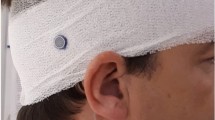Abstract
Objective
To perform preliminary tests in vitro and with healthy volunteers to determine the 3-T MRI compatibility of a cochlear implant with a non-removable magnet.
Methods
In the in vitro phase, we tested six implants for temperature changes and internal malfunctioning. We measured the demagnetisation of 65 internal magnets with different tilt angles between the implant’s magnetic field (bi) and the main magnetic field (b0). In the in vivo phase, we tested 28 operational implants attached to the scalps of volunteers with the head in three different positions.
Results
The study did not find significant temperature changes or electronic malfunction in the implants tested in vitro. We found considerable demagnetisation of the cochlear implant magnets in the in vitro and in vivo testing influenced by the position of the magnet in the main magnetic field. We found that if the bi/b0 angle is <90°, there is no demagnetisation; if the bi/b0 angle is >90°, there is demagnetisation in almost 60 % of the cases. When the angle is around 90°, the risk of demagnetisation is low (6.6 %).
Conclusion
The preliminary results on cochlear implants with non-removable magnets indicate the need to maintain the contraindication of passage through 3-T MRI.
Key Points
• Magnetic resonance imaging can affect cochlear implants and vice versa.
• Demagnetisation of cochlear implant correlates with the angle between bi and b0.
• The position of the head in the MRI influences the demagnetisation.
• Three-Tesla MRI for cochlear implants is still contraindicated.
• However some future solutions are discussed.








Similar content being viewed by others
References
Chou CK, McDougall JA, Can KW (1995) Absence of radiofrequency heating from auditory implants during magnetic resonance imaging. Bioelectromagnetics 16:307–316
Heller JW, Brackmann DE, Tucci DL, Nyenhuis JA, Chou CK (1996) Evaluation of MRI compatibility of the modified nucleus multichannel auditory brainstem and cochlear implants. Am J Otol 17:724–729
Teissl C, Kremser C, Hochmair ES, Hochmair-Desoyer IJ (1998) Cochlear implants: in vitro investigation of electromagnetic interference at MR imaging: compatibility and safety aspects. Radiology 208:700–708
Teissl C, Kremser C, Hochmair ES, Hochmair-Desoyer IJ (1999) Magnetic resonance imaging and cochlear implants: compatibility and safety aspects. J Magn Reson Imaging 9:26–38
Vincent C, Ruzza I, Vaneecloo FM, Dubrulle F (2008) Magnetic resonance imaging with the Digisonic SP Neurelec cochlear implant. Eur Arch Otorhinolaryngol 265:1043–1046
Graham J, Lynch C, Weber B, Stollwerck L, Wei J, Brookes G (1999) The magnetless Clarion cochlear implant in a patient with neurofibromatosis 2. J Laryngol Otol 113:458–463
Weber BP, Neuburger J, Goldring JE et al (1999) Clinical results of the CLARION magnetless cochlear implant. Ann Otol Rhinol Laryngol Suppl 177:22–26
Wackym PA, Michel MA, Prost RW, Banks KL, Runge-Samuelson CL, Firszt JB (2004) Effect of magnetic resonance imaging on internal magnet strength in Med-El Combi 40+ cochlear implants. Laryngoscope 114:1355–1361
Gubbels SP, McMenomey SO (2006) Safety study of the Cochlear Nucleus 24 device with internal magnet in the 1.5 Tesla magnetic resonance imaging scanner. Laryngoscope 116:865–871
Youssefzadeh S, Baumgartner W, Dorffner R, Gstöttner W, Trattnig (1998) MR compatibility of Med EL cochlear implants: clinical testing at 1.0 T. J Comput Assist Tomogr 22:346–350
Baumgartner WD, Youssefzadeh S, Czerny C, Hamzavi J, Adunka O, Gstoettner W (2000) Clinical utilization of magnetic resonance imaging for patients with cochlear implants. Wien Klin Wochenschr 112:512–514, German
Baumgartner WD, Youssefzadeh S, Hamzavi J, Czerny C, Gstoettner W (2001) Clinical application of magnetic resonance imaging in 30 cochlear implant patients. Otol Neurotol 22:818–822
Crane BT, Gottschalk B, Kraut M, Aygun N, Niparko JK (2010) Magnetic resonance imaging at 1.5 T after cochlear implantation. Otol Neurotol 31:1215–1220
Schmerber S, Reyt E, Lavieille JP (2003) Is magnetic resonance imaging still a contraindication in cochlear-implanted patients? Eur Arch Otorhinolaryngol 260:293–294
Fritsch MH, Mosier KM (2007) MRI compatibility issues in otology. Curr Opin Otolaryngol Head Neck Surg 15:335–340
Dubrulle F, Vincent C, Varoquaux A, Ernst O, Veillon F (2011) Guidelines for the performance of MRI in patients with cochlear implants. J Radiol 92:872–877, French
Deneuve S, Loundon N, Leboulanger N, Rouillon I, Garabedian EN (2008) Cochlear implant magnet displacement during magnetic resonance imaging. Otol Neurotol 29:789–790
Jeon JH, Bae MR, Chang JW, Choi JY (2012) Reversing the polarity of a cochlear implant magnet after magnetic resonance imaging. Auris Nasus Larynx 39:415–417
Majdani O, Leinung M, Rau T et al (2008) Demagnetization of cochlear implants and temperature changes in 3.0 T MRI environment. Otolaryngol Head Neck Surg 139:833–839
Acknowledgment
The authors declare no conflicts of interest.
Author information
Authors and Affiliations
Corresponding author
Rights and permissions
About this article
Cite this article
Dubrulle, F., Sufana Iancu, A., Vincent, C. et al. Cochlear implant with a non-removable magnet: preliminary research at 3-T MRI. Eur Radiol 23, 1510–1518 (2013). https://doi.org/10.1007/s00330-012-2760-3
Received:
Revised:
Accepted:
Published:
Issue Date:
DOI: https://doi.org/10.1007/s00330-012-2760-3




